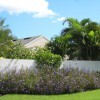Abstract
Environmental tolerance, abundant seed production, and an ability to easily grow from plant stem sections have allowed Mexican petunia to spread into natural areas that border urban areas. The Florida Exotic Pest Plant Council lists Mexican petunia (wild-type and non-sterile cultivars) as a Category 1 invasive species, meaning that it is “altering native plant communities by displacing native species, changing community structures or ecological functions, or hybridizing with natives.” These potential changes to community structure and ecological function are of particular concern in Florida wetlands, where changes to plant communities have the potential to impact not just plant-animal interactions, but also overall hydrology on a whole watershed level. This 6-page fact sheet was written by C. A. Reinhardt Adams, C. Wiese, L.C. Lee, S.B. Wilson, A. M. Smith, and R. Freyre, and published by the UF Department of Environmental Horticulture, April 2014.
References
Adams, C., C. Wiese, and L.C. Cobb. 2013. Effect of Season and Number of Glyphosate Applications on Control of Invasive Ruellia simplex. Journal of Invasive Plant Science and Management. Submitted.
Baskin, Y. 2002. The greening of horticulture: New codes of conduct aim to curb plant invasions. BioScience. 52:464-471. https://doi.org/10.1641/0006-3568(2002)052[0464:TGOHNC]2.0.CO;2
Coats, V.C., L.B. Stack, and M.E. Rumpho. 2011. Maine nursery and landscape industry perspectives on invasive plant issues. Invasive Plant Science and Management. 4:378-389. https://doi.org/10.1614/IPSM-D-10-00086.1
Czarnecki, D.M. II and Z. Deng. 2009. Occurrence of unreduced female gametes leads to sexual polyploidization in lantana. Journal of the American Society for Horticultural Science. 134:560-566. https://doi.org/10.21273/JASHS.134.5.560
Ervin, G.N., B.D. Herman, J.T. Bried, and D.C. Holly. 2006. Evaluating non-native species and wetland indicator status as components of wetlands floristic assessment. Wetlands 26:1114-1129. https://doi.org/10.1672/0277-5212(2006)26[1114:ENSAWI]2.0.CO;2
Ezcurra, C. and T.F. Daniel. 2007. Ruellia simplex, an older and overlooked name for Ruellia tweediana and Ruellia coerulea (Acanthaceae). Darwiniana 45:201-203.
Florida Exotic Pest Plant Council. 2011. List of Invasive Plant Species. Florida Exotic Pest Plant Council. http://www.fleppc.org/list/09list.htm. Accessed Feb. 23, 2012.
Foxcroft, L.C., D.M. Richardson, J.R.U. Wilson. 2008. Ornamental plants as invasive aliens: Problems and solutions in Kruger National Park, South Africa. Environmental Management. 41:32-51. https://doi.org/10.1007/s00267-007-9027-9
Freyre, R., A. Moseley, G.W. Knox, and S.B. Wilson. 2012. Fruitless Ruellia simplex R10-102 ('Mayan Purple') and R10-108 ('Mayan White'). HortScience. 47:1808-1814. https://doi.org/10.21273/HORTSCI.47.12.1808
Gagliardi, J.A. and M.H. Brand. 2007. Connecticut nursery and landscape industry preferences for solutions to the sale and use of invasive plants. HortTechnology. 17:39-45. https://doi.org/10.21273/HORTTECH.17.1.39
Gooden, B., K. French. P.J. Turner. 2009. Invasion and management of a woody plant, Lantana camara L., alters vegetation diversity within wet sclerophyll forest in southeastern Australia. Forest Ecology and Management. 257:960-967. https://doi.org/10.1016/j.foreco.2008.10.040
[GRIN] Germplasm Resources Information Network. 2004. National Germplasm ResourcesLaboratory, Beltsville, Maryland. http://www.ars-grin.gov/cgibin/npgs/html/taxon.pl?419324. Accessed: November 2007
Hanula, J.L., S. Horn, and J.W. Taylor. 2009. Chinese privet (Ligustrum sinense) removal and its effect on native plant communities of riparian forests. Invasive Plant Science and Management. 2:292-300. https://doi.org/10.1614/IPSM-09-028.1
Hupp, K.V.S., A. M. Fox, S.B. Wilson, E. L. Barnett, and R. K. Stocker. 2009. Natural area weeds: Mexican petunia (Ruellia tweediana). UF/IFAS Extension ENH1155. 8p. https://doi.org/10.32473/edis-ep415-2009
Hupp, K.V.S. 2007. Investigating the determinants of local scale distribution of Ruellia tweediana (synonym R. brittoniana) in natural areas. M.S. Thesis. Gainesville, FL: University of Florida. 108 p.
UF/IFAS Invasive Plant Working Group (2013) IFAS Assessment of Non-Native Plants in Florida's Natural Areas. Cited from the Internet (21 May 2014), http://plants.ifas.ufl.edu/assessment/. https://doi.org/10.32473/edis-ag376-2013
Knox, G.W., S.B. Wilson, Z. Deng, and R. Freyre. 2013a. Alternatives to invasive plants commonly found in north Florida landscapes. UF/IFAS Extension ENH1206. 3p. https://doi.org/10.32473/edis-ep467-2013
Knox, G.W., S.B. Wilson, Z. Deng, and R. Freyre. 2013b. Alternatives to invasive plants commonly found in central Florida landscapes. IFAS Cooperative Extension ENH1207. 3p. https://doi.org/10.32473/edis-ep468-2013
Reichard, S.H. 2004. Conflicting values and common goals: Codes of conduct to reduce the threat of invasive species. Weed Technology. 18:1503-1507. https://doi.org/10.1614/0890-037X(2004)018[1503:CVACGC]2.0.CO;2
Reichard, S.H. and P. White. 2001. Horticulture as a pathway of invasive plant introductions in the United States. BioScience. 51:103-113. https://doi.org/10.1641/0006-3568(2001)051[0103:HAAPOI]2.0.CO;2
Tallent-Hasell, N.G. and M.S. Watt. 2009. The invasive Buddleja davidii. Botanical Review. 75:292-325. https://doi.org/10.1007/s12229-009-9033-0
Tobe, J. D., K. C. Burks, R. W. Cantrell, M. A. Garland, M. E. Sweeley, D. W. Hall, P. Wallace, G. Anglin, G. Nelson, J. R. Cooper, D. Bickner, K. Gillbert, N. Aymond, and K. Greenwood, N. Raymond. 1998. Florida wetland plants: An identification manual. Tallahassee, FL: Florida Department of Environmental Protection. 59 pp.
Trueblood, C.E., T.G. Ranney, N.P. Lynch, J.C. Neal, and R.T. Olsen. 2010. Evaluating fertility of triploid clones of Hypericum androsaemum L. for use as non-invasive landscape plants. HortScience. 45:1026-1028. https://doi.org/10.21273/HORTSCI.45.7.1026
Wiese, C., C. Reinhardt-Adams, and A. M. Smith. 2013. Experimental research informs control of Mexican petunia (Ruellia simplex) in natural areas and home-gardens. Proc. Fl. State Hort. Soc. 20:x-x. in press.
Wilson, S.B., P.C. Wilson, and J.A. Albano. 2004. Growth and development of the native Ruellia caroliniensis and invasive Ruellia tweediana. HortScience. 39:1015-1019. https://doi.org/10.21273/HORTSCI.39.5.1015
Wirth, F.F., K.J. Davis, and S.B. Wilson. 2004. Florida nursery sales and economic impacts of 14 potentially invasive landscape plant species. Journal of Environmental Horticulture. 22:12-16. https://doi.org/10.24266/0738-2898-22.1.12
Wunderlin, R.P. and B.F. Hansen 2013. Atlas of Florida Vascular Plants. http://www.plantatlas.usf.edu Accessed June 17, 2013.
USDA-NRCS U.S. Department of Agriculture Forest Service, Natural Resources Conservation Service. 2013. The PLANTS Database. http://plants.usda.gov. Accessed June. 17, 2013.

